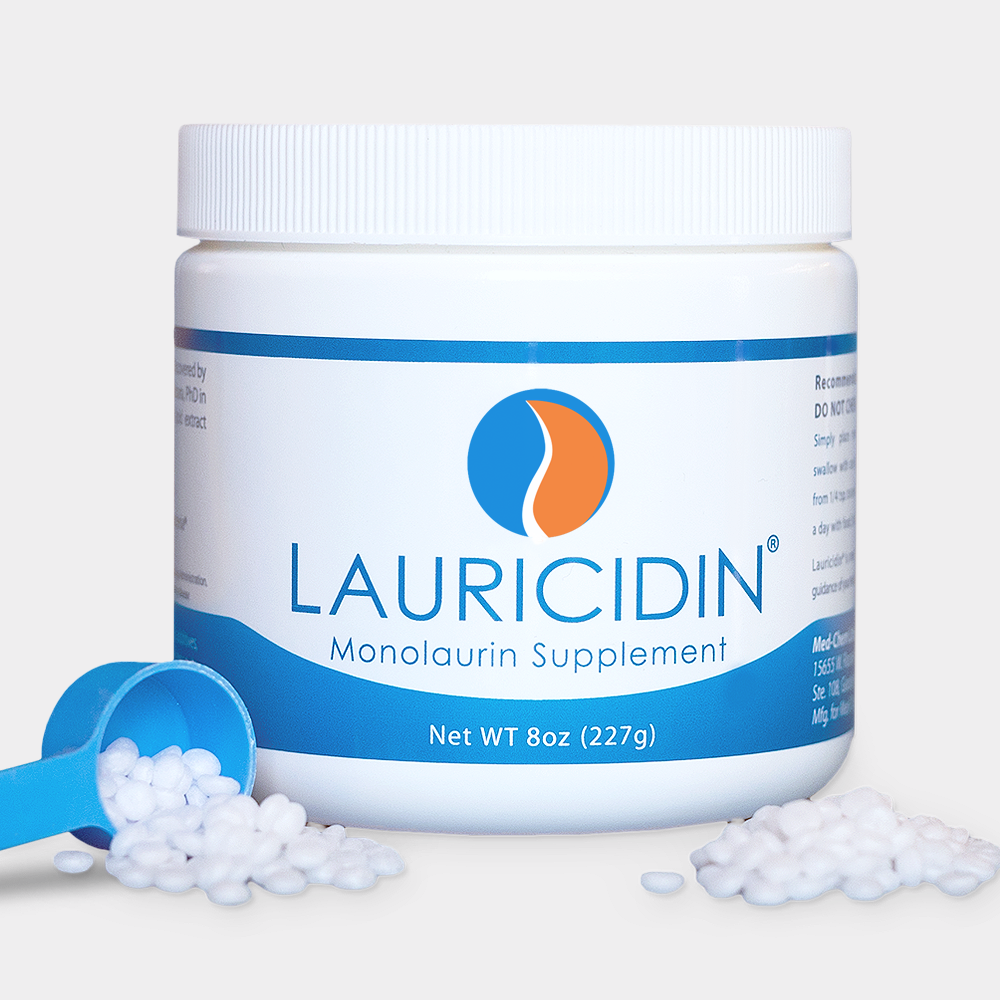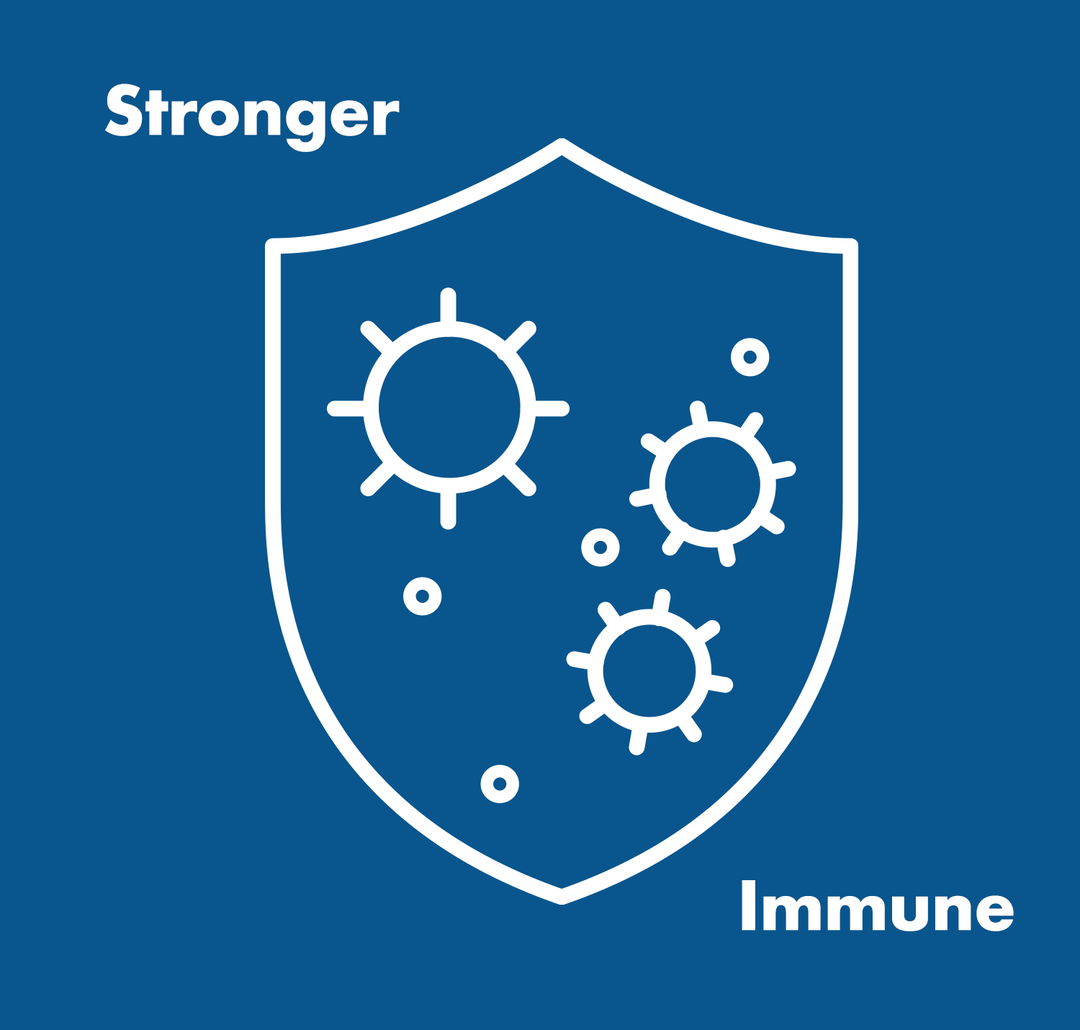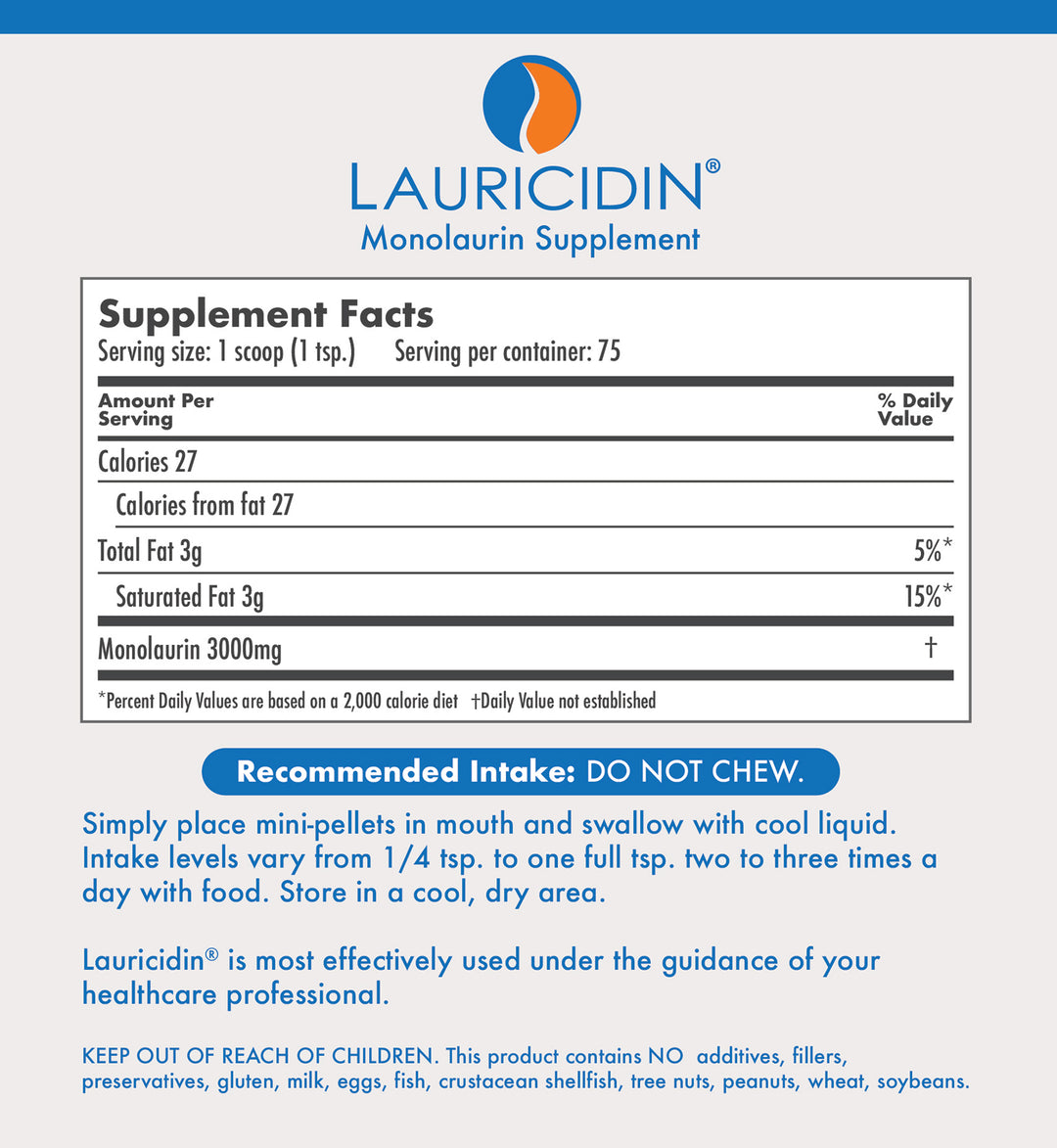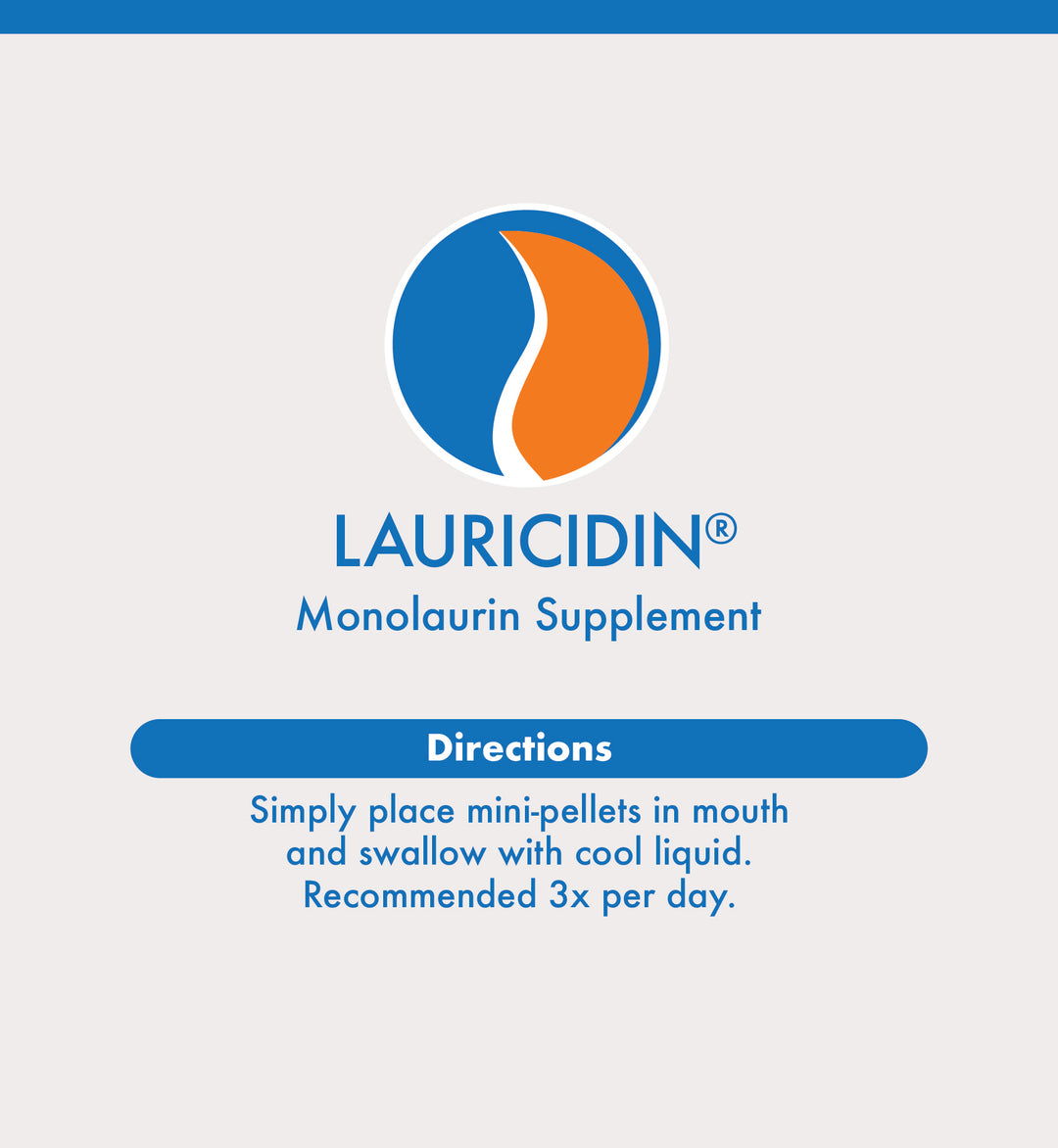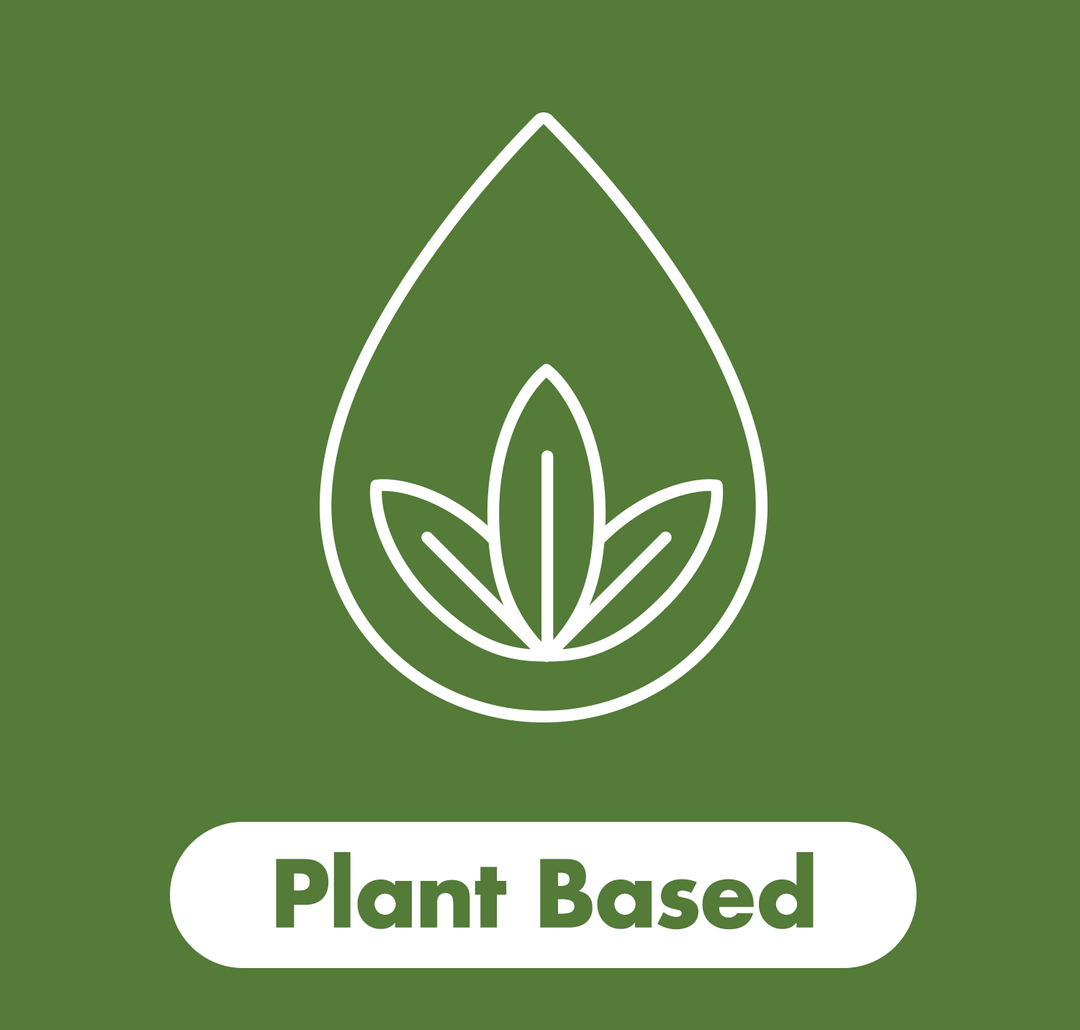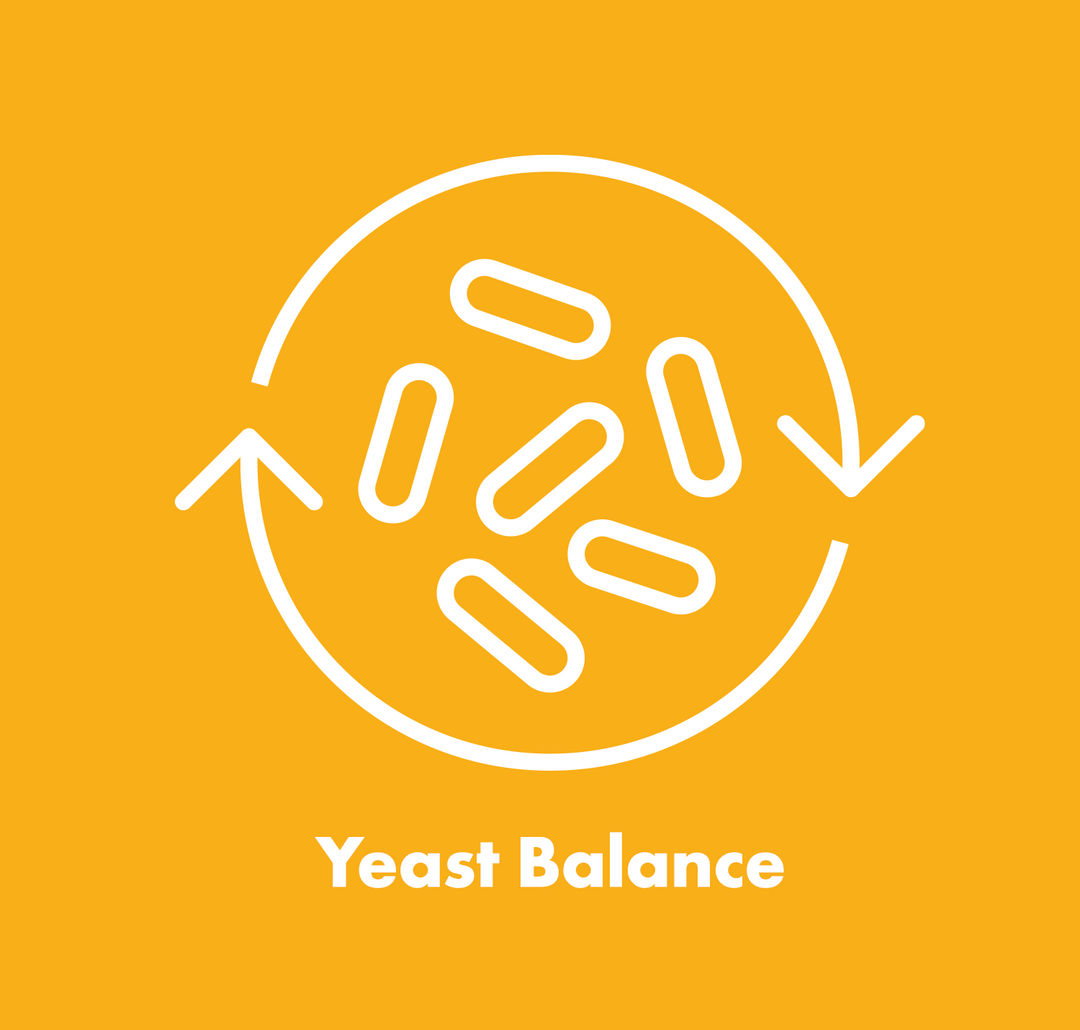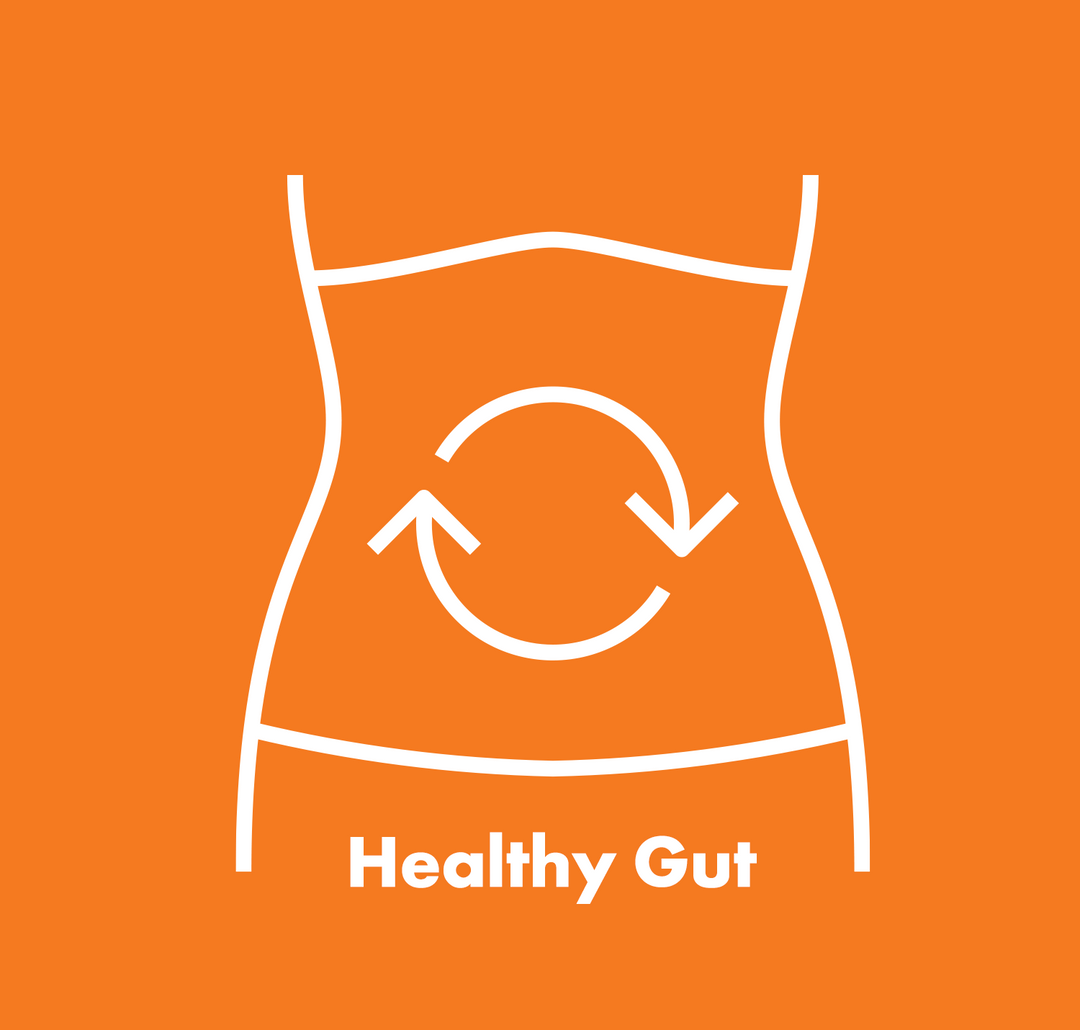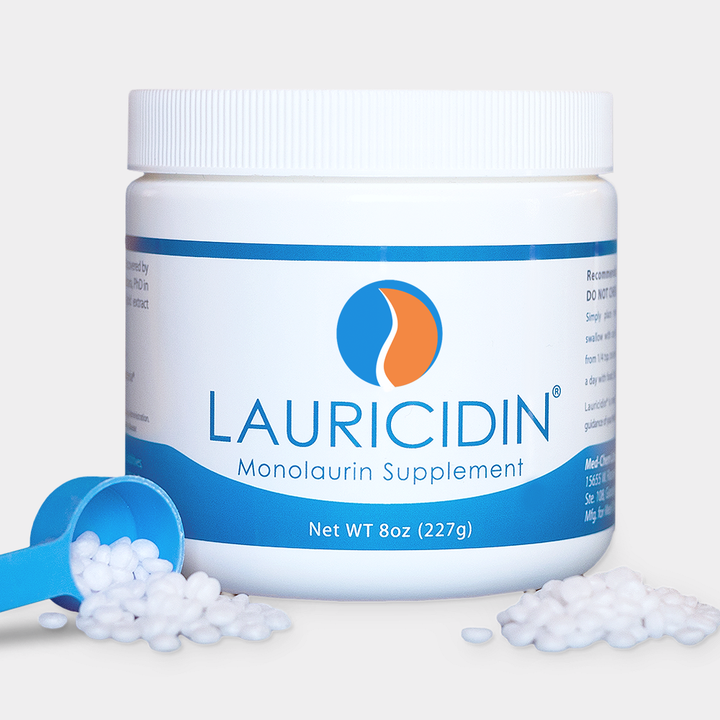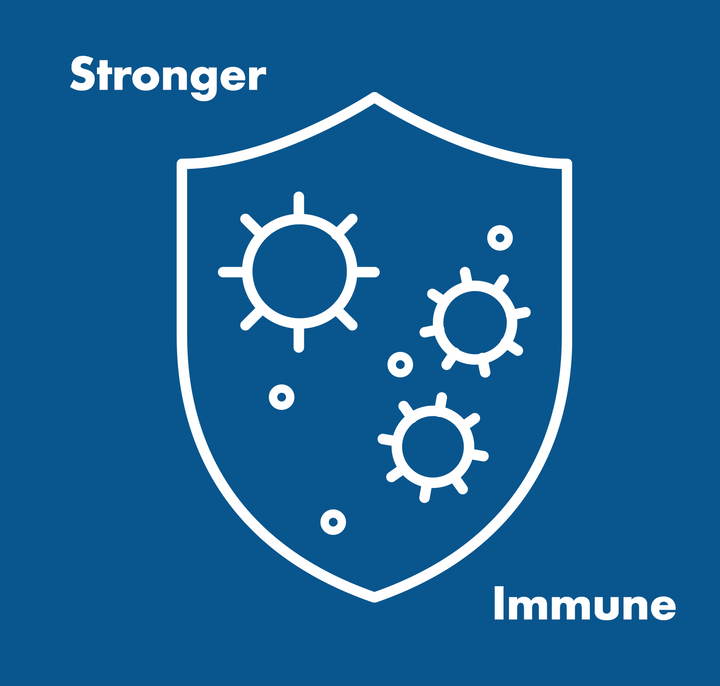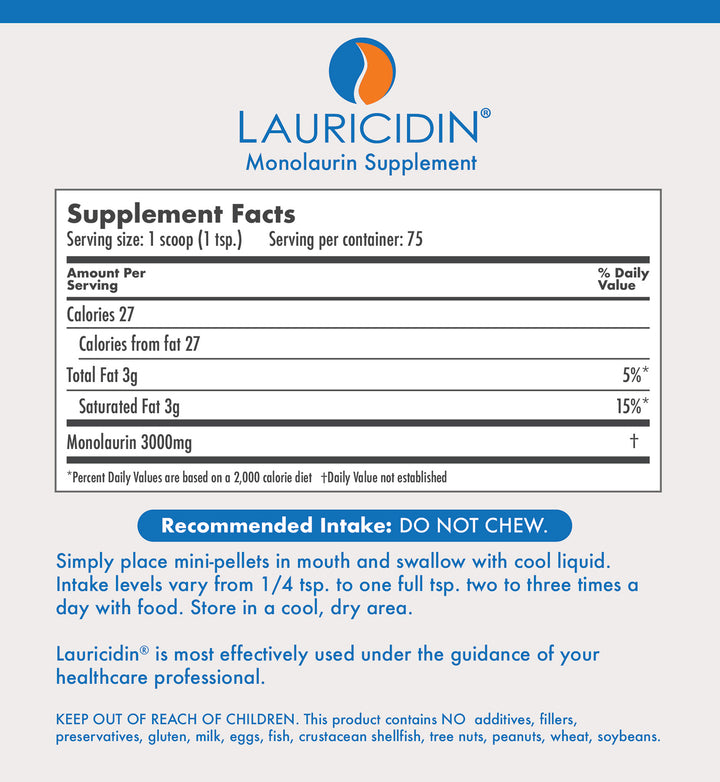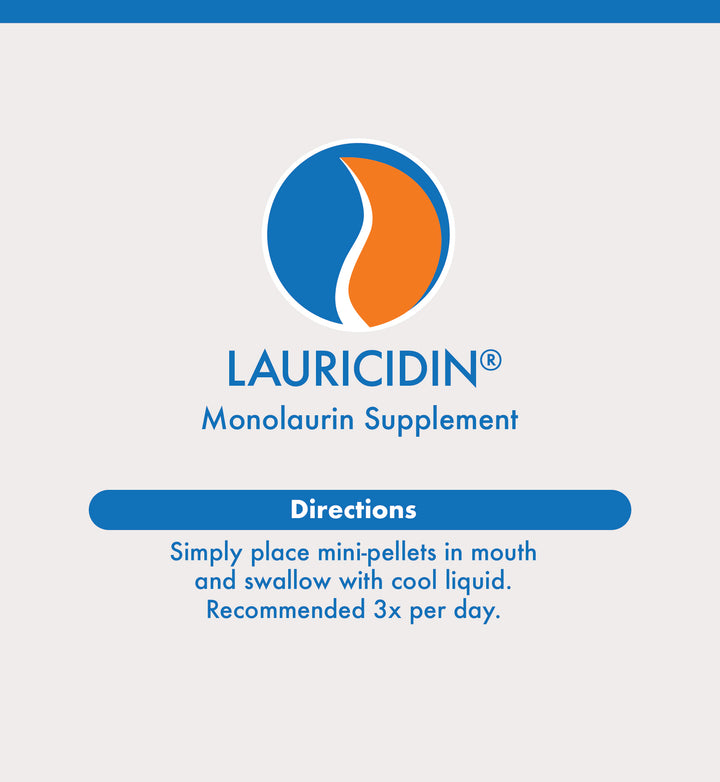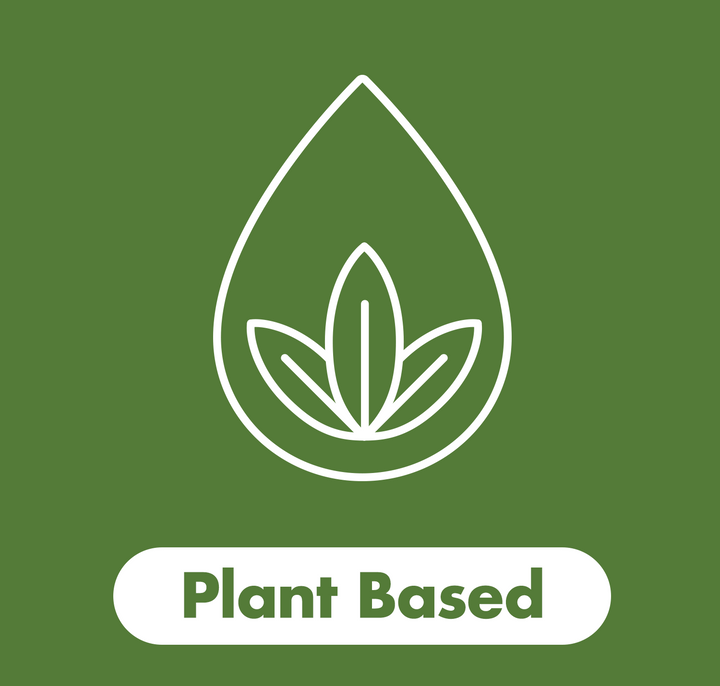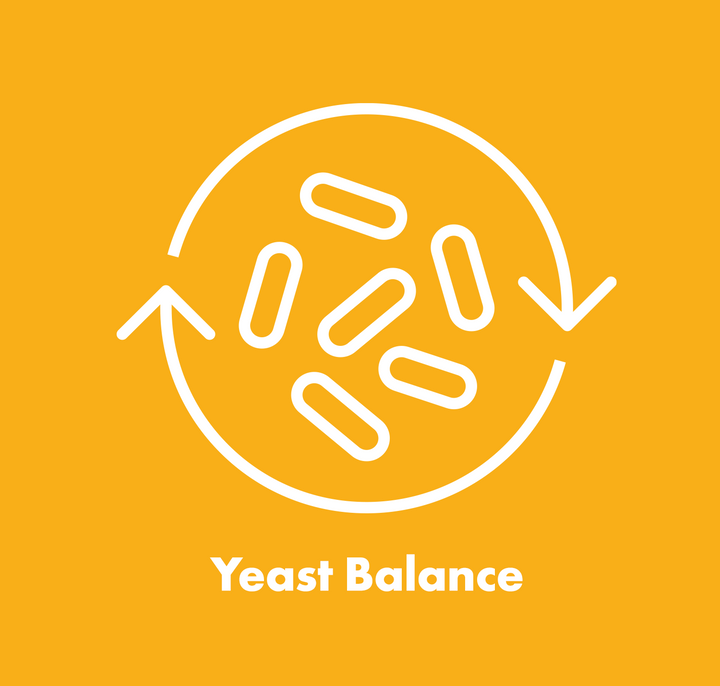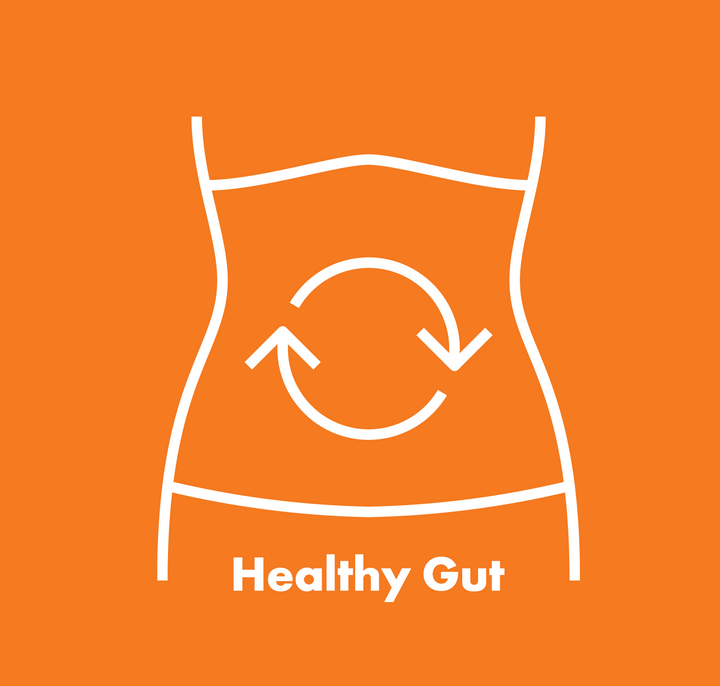Discover how this natural compound selectively wipes out harmful microbes while protecting your beneficial gut flora.
Learn how monolaurin outperforms antibiotics in targeting pathogens—without the side effects or resistance
Explore how monolaurin reshapes your gut ecosystem and strengthens your body’s immune defenses from the inside out.
Monolaurin, also known as glycerol monolaurate (GML), is a natural fatty acid mono-ester derived from lauric acid and glycerol. It is found in coconut oil and notably abundant in human breast milk, where it is thought to help protect infants from infections and shape a healthy gut microbiome.
Monolaurin is widely used as a food-grade emulsifier and preservative and is on the FDA’s Generally Recognized as Safe (GRAS) list for oral consumption. Beyond its use in products, monolaurin has attracted interest for its broad-spectrum antimicrobial effects and its potential to support gut health. Unlike conventional antibiotics that may indiscriminately wipe out gut flora, monolaurin exhibits a selective antimicrobial action and additional anti-inflammatory benefits that could make it an ideal supplement for promoting a balanced human microbiome. Below, we present a structured review of how monolaurin works, its antimicrobial spectrum, selectivity for beneficial bacteria, effects on gut microbiota balance and immunity, supporting research, and safety considerations
What Is Monolaurin and How Does It Work?
Monolaurin is a monoglyceride of the 12-carbon medium-chain fatty acid lauric acid . It forms when lauric acid is esterified to a glycerol backbone. This compound possesses significantly greater antimicrobial potency than lauric acid itself – on the order of 200–400 times more effective – due to its unique structure and ability to integrate into microbial membranes. Monolaurin’s mechanism of action centers on its surfactant-like disruption of lipid membranes in microbes.
Being amphipathic, monolaurin can insert into the lipid bilayer of microorganisms, destabilizing the membrane and causing leakage of cellular contents or disintegration of the viral envelope. In bacteria, this interference with the plasma membrane leads to loss of membrane potential and cell death. In enveloped viruses, monolaurin literally dissolves the fatty envelope, thereby inactivating the virus’s ability to infect. Monolaurin also may inhibit microbial virulence by interfering with cell signaling and toxin production. For example, it has been shown to block the production of staphylococcal toxins and the signaling pathways that lead to inflammation in host cells. Interestingly, monolaurin’s effects are not limited to microbes – it can integrate into mammalian cell membranes as well, where it modulates membrane microdomains.
At higher concentrations, monolaurin was found to alter T-cell membrane dynamics and suppress excessive T-cell activation (reducing activation of LAT, PLC-γ, AKT pathways and cytokine release). This immunomodulatory action suggests monolaurin not only directly attacks pathogens but also calms hyperactive immune responses, which can be beneficial in inflammatory conditions. Importantly, concentrations of monolaurin that effectively kill pathogens do not appear to harm human cells in vivo – in fact, human serum factors (like albumin) likely buffer monolaurin’s cytotoxicity to protect host tissues. In summary, monolaurin is a naturally derived compound that works by physically disrupting microbial membranes and dampening pathogenic signaling, giving it broad antimicrobial and anti-inflammatory capabilities.

Table of Content
Broad Antimicrobial Effects of Monolaurin
Monolaurin is well-documented to have broad-spectrum antimicrobial effects against a variety of pathogens – including bacteria, viruses, fungi – and even has activity against microbial biofilms . These properties have been demonstrated in numerous in vitro studies and are summarized below:
Antibacterial Activity:
Monolaurin is a potent bactericide, especially against Gram-positive bacteria. It has been shown to suppress the growth of many Gram-positive pathogens such as Staphylococcus aureus (including MRSA), Streptococcus species, Bacillus species, Clostridium perfringens, and others. Monolaurin also inactivates certain Gram-negative bacteria, particularly those with more fragile outer membranes or “loose” lipopolysaccharide structures. For example, it can inhibit Escherichia coli and Helicobacter pylori under the right conditions.
However, highly robust Gram-negative rods (like some Pseudomonas or Enterobacteriaceae with strong LPS shields) tend to be intrinsically resistant to monolaurin’s direct effects. Overall, monolaurin’s lipid-disrupting action makes it broadly effective against many bacteria, including antibiotic-resistant strains, by attacking the physical integrity of bacterial membranes. Notably, a 2013 study confirmed monolaurin’s ability to kill S. aureus in mice and showed broad-spectrum effects in vitro without fostering resistance
Antiviral Activity:
A significant advantage of monolaurin is its capacity to inactivate enveloped viruses . The lipid envelope of many viruses is an easy target for monolaurin. Research has shown monolaurin to be virucidal against a wide range of enveloped RNA and DNA viruses. For instance, monolaurin can disable viruses like Herpes simplex virus , Influenza virus, Epstein–Barr virus , and even SARS-CoV-2 (the coronavirus responsible for COVID-19) by dissolving their envelopes .
In vitro, monolaurin treatment causes disintegration of viral particles and can also inhibit later stages of viral replication. One study noted that medium-chain fatty acids including lauric acid derivatives cause >99% reduction of coronavirus infectivity by disrupting the viral membrane. In a clinical context, higher circulating levels of monolaurin have been correlated with lower risk of contracting COVID-19, suggesting its antiviral effects translate to real-world protection. Monolaurin’s broad antiviral action is a key feature that ordinary antibiotics lack, making it a valuable adjunct for controlling viral infections that can upset the microbiome or cause systemic illness.
Antifungal Activity:
Monolaurin also exhibits activity against fungi and yeast. Several pathogenic fungi – including dermatophytes (like ringworm) and Candida albicans – are susceptible to monolaurin. In an in vitro model of Candida biofilm infection (oral thrush model), monolaurin had a measurable antifungal effect: it achieved a significant reduction in C. albicans biofilm viable cell counts at micromolar concentrations, and importantly, it downregulated fungal-induced inflammatory cytokines (like IL-1α/β) from co-cultured human cells. In vivo studies in mice have also shown monolaurin can combat Candida infections (e.g. oral candidiasis), supporting its potential as an antifungal treatment. These findings indicate monolaurin can help control yeast overgrowth (such as Candida in the gut or on mucosal surfaces) while also tempering the host’s pro-inflammatory response to these fungi.
Anti-Biofilm Effects:
A particularly important aspect of monolaurin’s antimicrobial action is its ability to disrupt biofilms . Microbial biofilms (protective communities that bacteria and fungi form) make infections harder to eradicate and can chronically perturb the microbiome (e.g., in the gut, oral cavity, or on medical devices). Monolaurin has demonstrated significant antibiofilm activity.
A 2024 study on MRSA (biofilm-forming S. aureus) found that monolaurin not only inhibited the formation of staph biofilms but also was able to eradicate pre-existing biofilms at sufficient concentrations. The researchers observed a dose-dependent reduction in biofilm mass and viability, with monolaurin reducing attachment of bacterial cells (confirmed by electron microscopy) and downregulating biofilm-associated genes in MRSA. Monolaurin’s IC_50 for disrupting established MRSA biofilms was in the low hundreds of µg/mL, indicating potent activity.
Similarly, monolaurin’s ability to break down Candida biofilms (noted above) suggests a broad anti-biofilm capability. By busting biofilms, monolaurin can help overcome one of the key defenses of chronic infections and ensure that pathogenic reservoirs in the gut or elsewhere are more fully eliminated.

In sum, monolaurin is a broad-spectrum antimicrobial that can target bacteria (including drug-resistant strains), enveloped viruses, and fungi, and can even penetrate microbial biofilms. These actions are achieved through its membrane-disrupting and virucidal properties. This broad activity is beneficial for the microbiome because it can reduce or eliminate many potential pathogens or overgrowths that disturb gut health – ranging from Clostridia that produce toxins, to yeast overgrowth, to viral triggers of gut inflammation. Monolaurin acts somewhat like a “mild disinfectant” for the GI tract and body, but as we discuss next, it does so in a way that spares the beneficial microbes to a remarkable extent.
"For example, it has been shown to block the production of staphylococcal toxins and the signaling pathways that lead to inflammation in host cells."
Selectivity: Sparing Beneficial Gut Flora While Targeting Pathogens
A critical question for any antimicrobial intended to support the microbiome is whether it harms the beneficial commensal bacteria. One of monolaurin’s most remarkable features is its selectivity : it preferentially inhibits pathogenic organisms while having minimal or even growth-promoting effects on many beneficial bacteria in the gut. This selectivity has been observed in both experimental studies and is suggested by its natural role in breast milk.
1. Coconut Extract
Research has shown that the antimicrobial spectrum of monolaurin excludes certain beneficial bacteria . In particular, many lactic acid bacteria which are key members of a healthy gut (such as Lactobacillus and Bifidobacterium species, as well as some Enterococcus strains) are inherently resistant to monolaurin’s effects.
A comprehensive evaluation noted that “the antimicrobial properties of GML extend to nearly all Gram-positive bacterial species except certain lactobacilli, bifidobacteria, and enterococci.”. These commensal organisms show little growth inhibition in the presence of monolaurin. In fact, the reason appears to be that some of these beneficial bacteria produce their own.

2. Mother's Milk
The selectivity of monolaurin is exemplified in human breast milk. Human milk contains ~3 g/L of monolaurin, whereas cow’s milk has only trace amounts. This difference is thought to be one reason human breast milk so effectively promotes a healthy infant microbiome. In tests comparing breast milk vs. infant formula, human milk showed strong inhibition of pathogenic bacteria (including S. aureus, C. perfringens, E. coli, etc.), whereas an innocuous gut commensal (E. faecalis producing a GML analog) was not inhibited.
When monolaurin and similar lipids were removed from breast milk, the milk lost its antibacterial activity, but adding pure monolaurin back restored the antimicrobial effect. Thus, monolaurin in milk selectively targets pathogens while sparing the beneficial lactic acid bacteria that infants need for digestion and immune development.

Moreover, breastfed infants tend to have gut microbiota dominated by Bifidobacterium and Lactobacillus, partly due to milk oligosaccharides but also likely because monolaurin and other milk antimicrobials keep pathogens at bay. The net result is a lower gut pH and an environment in which beneficial fermenters outcompete harmful bacteria. This natural scenario provides a model for how supplemental monolaurin might help adults: by selectively pruning pathogenic microbes (e.g., E. coli or Clostridia that can cause dysbiosis) and allowing commensals to flourish.
Monolaurin Spotlight
Effects on Gut Microbiota Balance and Composition
Because of its selective antimicrobial action, monolaurin has notable effects on the composition of the gut microbiota. Emerging research in animal models demonstrates that oral monolaurin supplementation can shift the gut microbial balance toward a healthier, more beneficial profile . These changes often correlate with improved metabolic and inflammatory outcomes. Here we summarize key findings from studies examining monolaurin’s impact on gut flora:
Enhancing Beneficial Bacteria:
Multiple studies report that monolaurin increases the relative abundance of probiotic and beneficial microbes in the gut. For example, Zhao et al. (2019) studied diet-induced obese mice and found that adding GML to a high-fat diet significantly ameliorated gut dysbiosis . High-dose GML supplementation (450 mg/kg) led to increases in Bacteroides uniformis, Akkermansia , Bifidobacterium, and Lactobacillus populations, while reducing levels of opportunistic or pro-inflammatory taxa like Escherichia coli, Lactococcus (a genus including some pathobionts), and Flexispira.
The enrichment of Akkermansia is particularly notable, as this mucin-degrading bacterium is associated with improved metabolic health and gut barrier function. Similarly, in a mouse model of colitis (DSS-induced inflammatory bowel disease), oral GML (500 mg/kg) increased the abundance of commensal bacteria such as Akkermansia muciniphila and Lactobacillus murinus in the colon. Another study (Mo et al., 2021) showed that when mice were pretreated with GML before inducing colitis, they had significantly higher levels of Lactobacillus and Bifidobacterium in their gut, along with increased production of beneficial short-chain fatty acids (SCFAs) like propionate and butyrate. These SCFAs are metabolic byproducts of good bacteria that nourish colon cells and modulate immunity.
Notably, fecal microbiota transplants (FMT) from the GML-treated mice could transfer the protective effect to other mice, indicating that the GML-altered microbiome itself conferred resistance to colitis. All these findings point to monolaurin’s ability to up-regulate beneficial indigenous microbiota and foster a community structure associated with gut health.

Reducing Pathogenic and Opportunistic Species:
Concomitant with boosting probiotics, monolaurin consistently depresses the levels of harmful bacteria in the gut. In the high-fat diet study mentioned, monolaurin-supplemented mice saw a drop in E. coli and other potentially pathogenic Proteobacteria. In piglets challenged with enterotoxigenic E. coli (a cause of post-weaning diarrhea), adding monolaurin (with formic acid) to the diet mitigated the infection – an effect likely due to direct inhibition of the pathogen and an improved inflammatory profile in the gut.
Monolaurin’s known efficacy against Clostridium perfringens suggests it may also help prevent overgrowth of toxin-producing clostridia in the intestine. Likewise, by keeping yeast like Candida in check (through its antifungal action), monolaurin can prevent fungal overgrowth that sometimes follows antibiotic use or occurs in dysbiosis. The net effect is a microbiota with fewer pathogens and opportunists , which reduces the inflammatory and toxic burden on the host. Researchers have noted that monolaurin can “upregulate favorable microbial taxa without inducing systemic inflammation”, indicating it trims the bad actors while keeping the immune system calm (unlike broad antibiotics that often cause endotoxin release from Gram-negatives).
Microbiome-Driven Metabolic Benefits:
The shifts in microbiota induced by monolaurin have functional consequences. In obese mice, the increase in Akkermansia and SCFA-producing bacteria from GML was linked to improved metabolic parameters – including less visceral fat gain, improved cholesterol levels, and enhanced insulin sensitivity. Monolaurin-treated obese mice had lower circulating endotoxin (LPS) levels and reduced inflammation (TNF-α), which the authors attributed to the altered gut flora and strengthened gut barrier.
In the colitis model, the GML-driven rise in Lactobacillus/Bifidobacterium and butyrate was associated with increased colonic regulatory T-cells (Foxp3+ Tregs) and an elevated ratio of anti-inflammatory to pro-inflammatory cytokines, helping resolve the colitis. Thus, monolaurin doesn’t just change the microbiota composition in a vacuum – it shifts the metabolic output of the microbiome (more SCFAs, less endotoxin) in a direction that promotes host health. This highlights a virtuous cycle: monolaurin creates a microbiome that is less inflammatory and more metabolically beneficial, which in turn contributes to better immune regulation and gut homeostasis.
Dose-Dependent Effects:
It’s worth noting that monolaurin’s impact on gut microbes can be dose-dependent. Low doses might not exert the full beneficial effect and, if too low, could theoretically allow partial resistance. One study reported that a very low dose (150 mg/kg) of GML over long-term in healthy mice led to some dysbiosis and metabolic changes, whereas moderate to high doses (300–450 mg/kg) had clear beneficial effects on microbiota and metabolism.
Another study found no adverse microbiome changes at 150 mg/kg for 6 weeks, indicating results may depend on context and baseline diet. Overall, the consensus from animal studies is that adequate dosing of monolaurin tends to promote a healthier microbial balance, whereas sub-therapeutic dosing is not particularly useful. In practical terms, this means that when using monolaurin as a supplement for microbiome support, one should use a sufficiently robust dose to achieve the antimicrobial effects (more on dosage in a later section).
Immune Modulation and Epithelial Barrier Integrity
In summary, monolaurin supplementation has been shown to tilt the gut microbiota toward a more favorable composition : increasing beneficial commensals (Lactobacillus, Bifidobacterium, Akkermansia, SCFA-producers) and decreasing undesirable microbes (pathogenic E. coli, clostridia, etc.). These changes are associated with improved gut health markers – reduced inflammation, better barrier integrity, and even systemic metabolic benefits. This body of evidence – mostly from animal models – strongly suggests that monolaurin can help restore or maintain microbiome balance, especially in situations of dysbiosis or metabolic stress.
Beyond directly altering the microbial composition, monolaurin exerts significant immunomodulatory effects and helps preserve the integrity of the gut’s epithelial barrier. A healthy microbiome is intertwined with a well-regulated immune system and an intact intestinal lining – monolaurin appears to support all three pillars (microbes, immunity, barrier) of gut health. Key points on monolaurin’s immune and barrier effects:
" Monolaurin supplementation has been shown to tilt the gut microbiota toward a more favorable composition"
Anti-Inflammatory Action:
Monolaurin has consistently been found to reduce excessive inflammatory signals. It acts at the level of epithelial cells and immune cells to prevent harmful inflammation triggered by pathogens. For example, in cell culture models, pathogenic bacteria or toxins usually induce pro-inflammatory cytokines like IL-8 from intestinal epithelial cells, which can recruit neutrophils and damage tissue. Human breast milk (rich in GML) was shown to inhibit the production of IL-8 by human epithelial cells when they were exposed to bacterial toxins, whereas formula (no GML) had no such effect. Removing GML from the milk abolished this anti-inflammatory property.
This indicates GML is a key factor in milk’s immunomodulatory effect, preventing an overzealous inflammatory response to microbes. Similarly, monolaurin can inhibit superantigen toxins (like staph toxic shock syndrome toxin) from triggering massive cytokine release. In vivo, monolaurin has been shown to suppress mucosal inflammation: Schlievert et al. found that GML application in vaginal models blocked the local production of pro-inflammatory chemokines and prevented immune cell influx that would normally disrupt the mucosal barrier. In the gut context, mouse studies echo this anti-inflammatory effect . In a DSS-colitis model, GML-treated mice had significantly lower levels of TNF-α, IL-1α, and IL-1β in colon tissue, coupled with higher levels of the anti-inflammatory cytokine IL-10 and regulatory TGF-β. Monolaurin effectively inhibited the MAPK and NF-κB signaling pathways in the intestine, which are major drivers of inflammatory gene expression. It also led to a decrease in pro-inflammatory immune cells in the gut mucosa: treated mice showed fewer Th17 cells, neutrophils, and macrophages infiltrating the colon compared to untreated colitic mice.
This corresponds with a more regulated, less inflammatory immune state. Interestingly, monolaurin’s immune-calming reaches the adaptive immune system as well – as mentioned earlier, studies on human T-cells found that monolaurin dampens T-cell activation and lowers their secretion of inflammatory cytokines like IL-2, IFN-γ, and TNF-α. So, whether at the level of innate epithelial responses or adaptive T-cell responses, monolaurin tones down excessive inflammation . This is highly beneficial in the context of maintaining gut health, as chronic low-grade inflammation is a known contributor to microbiome imbalance and conditions like IBD.
Support of the Intestinal Barrier:
The gut epithelial barrier is crucial for microbiome containment and overall health – it prevents pathogens and toxins from leaking into circulation while allowing nutrient absorption. Monolaurin helps fortify this barrier. In the DSS-colitis mice, those given monolaurin showed improved histological tissue preservation and significantly increased expression of tight junction proteins in intestinal tissue.
Tight junction proteins (like occludin, claudins) seal the spaces between intestinal cells, so their upregulation indicates a tightening of the gut barrier. By reducing inflammation (which otherwise would open up junctions) and by potentially acting on epithelial cells directly, GML maintained mucosal integrity in the face of inflammatory insult. Another clue comes from cytokines: high-dose GML feeding in mice elevated IL-22 levels, an important cytokine from innate lymphoid cells that promotes mucus production and epithelial cell repair in the gut.
The combination of less inflammatory damage and direct enhancement of barrier proteins means monolaurin helps prevent “leaky gut” phenomena. Furthermore, by disrupting pathogen growth and biofilms, monolaurin reduces direct attacks on the epithelium (e.g., toxins from C. perfringens or cytotoxins from E. coli), indirectly safeguarding the barrier. In a broader sense, monolaurin has been shown to prevent mucosal barrier disruption in other models – for instance, in vaginal tissue models, GML prevented a superantigen from opening the epithelial barrier that would have allowed toxins or viruses to penetrate. We can extrapolate a similar protective effect in the gut: by keeping local inflammation down and pathogens under control, the epithelial lining remains uncompromised.
Clinical and Preclinical Evidence Supporting Monolaurin’s Use
Animal Models:
As detailed above, animal studies strongly support monolaurin’s beneficial effects on gut health. In addition to the mouse models of obesity and colitis, studies in livestock have shown benefits. Piglets given monolaurin as a feed supplement had improved growth and reduced inflammatory responses when challenged with pathogens, indicating it can substitute for antibiotics in promoting gut health in agriculture.
Monkeys have been given high concentrations of GML vaginally and orally with no adverse effects and reduced infection rates. These preclinical models provide proof-of-concept that monolaurin can enhance host resilience to infections and inflammation in vivo.

Human Observational Data:
Direct clinical trials on oral monolaurin for microbiome or gut outcomes are still limited. However, we can draw from several lines of evidence in humans:
Breastfed Infants
Infants who consume monolaurin-rich breast milk tend to have lower incidences of GI infections, thrush, and even lower risk of inflammatory conditions like atopic dermatitis. While breast milk has many factors, studies pinning the difference between human and formula feeding have identified GML as a key contributor to human milk’s antimicrobial and anti-inflammatory advantages. This suggests that dietary monolaurin intake (via milk) yields clinically observable benefits in microbiome-mediated outcomes (infection protection, allergic inflammation reduction).
COVID-19 Cohort:
A recent metabolomics study of healthcare workers during the COVID-19 pandemic found that individuals who remained uninfected had, on average, twice the circulating monolaurin levels compared to those who contracted the virus. Monolaurin was one of the top discriminating metabolites associated with resistance to infection. This correlation, while not a controlled intervention, aligns with monolaurin’s antiviral and immune-supportive role. It hints that people with higher monolaurin (perhaps from diet or supplementation) might experience fewer infections, which indirectly benefits the microbiome (since infections and antiviral treatments can disturb microbiota).

Topical and Other Uses:
Monolaurin has been tested in human-focused applications such as vaginal health and skin infections. In a clinical study, a small dose of monolaurin (~8 mg) applied via tampon significantly improved vaginal health by suppressing S. aureus toxin production and reducing local IL-8 inflammation, without any adverse effects. Another trial compared monolaurin to conventional antibiotics for pediatric skin infections and found broad-spectrum efficacy without fostering resistance. While these are not gut-specific, they demonstrate monolaurin’s safety and effectiveness in human therapeutic contexts. They also reinforce the idea that monolaurin can be an alternative or adjunct to antibiotics for managing infections.
Anecdotal and Clinical Use:
Monolaurin supplements (often derived from coconut oil as lauricidin ) have been used in integrative medicine for conditions like chronic Candida overgrowth, recurrent viral infections (e.g., Epstein-Barr, herpes), and even as part of Helicobacter pylori management protocols. Although robust clinical trial data are lacking in some of these areas, case reports and functional medicine practitioners have noted improvements in patients’ GI symptoms and immune markers when using monolaurin as part of a regimen for dysbiosis or stealth infections.
Given its low risk profile, some clinicians empirically add monolaurin for patients with suspected gut microbial imbalances, seeing improvements in issues like bloating (possibly by reducing small intestinal bacterial overgrowth), frequency of infections, or markers of gut inflammation. These observations align with the mechanistic evidence we have reviewed.
In summary, the body of evidence – spanning in vitro experiments, animal studies, and preliminary human data – consistently supports the idea that monolaurin can promote gut and systemic health . It reduces harmful microbes, supports beneficial ones, and modulates immune responses in a way that is conducive to microbiome equilibrium. While we await larger controlled trials in humans to quantify benefits for specific conditions, the existing data provide a strong scientific rationale for considering monolaurin as a supplement to maintain or restore a healthy microbiome.
Safety Profile and Dosage Considerations
Monolaurin’s safety profile is excellent , which is a crucial factor when recommending any supplement for health maintenance. Key points regarding safety and dosing:
Generally Recognized as Safe (GRAS)
Monolaurin is classified by the U.S. FDA as a GRAS substance for use in foods. It has been used for decades as a food preservative and emulsifier in items like ice cream and cosmetics, meaning humans are regularly exposed to small amounts through diet and topical products with no ill effect. The fact that human breast milk naturally contains high levels of monolaurin (around 3000 µg/mL) also attests to its safety for infant consumption in significant quantities.
Tolerability:
Studies indicate that monolaurin is well-tolerated even at relatively high doses. In a Rhesus macaque study, chronic application of a very high concentration (5% GML, ~50 mg/mL) caused no observable toxicity. Similarly, human volunteers given coconut oil rich in monolaurin had no side effects in a clinical trial, supporting its safety in oral intake.
Gastrointestinal side effects are rare; monolaurin is a medium-chain lipid, so it’s generally easily digested and absorbed. Some people starting monolaurin supplements report mild, transient GI upset or a “die-off” reaction (Herxheimer effect) if a large pathogen load is rapidly killed, but this is typically managed by starting with a low dose and gradually increasing. Importantly, monolaurin does not appear to disrupt liver or kidney function, hematologic parameters, or other systemic markers in animal studies even with long-term use.
No Microbiome Damage:
Unlike broad antibiotics, monolaurin’s selective action means it’s unlikely to cause dysbiosis when taken at appropriate doses. In fact, as reviewed, it tends to improve microbiome composition. One precaution from the research: extremely low doses of monolaurin (far below effective levels) might not yield benefits and could, in unusual circumstances, allow resistant microbes to fill niches (as one mouse study with an insufficient dose suggested).
Thus, the dose should be sufficient to achieve antimicrobial effect – analogous to not under-dosing an antibiotic. But at commonly used supplemental doses, monolaurin has not been associated with overgrowth of any particular harmful species. On the contrary, it has a probiotic-sparing effect . This safety for the microbiome is a major advantage – health professionals need not worry that monolaurin will wipe out a patient’s healthy gut bacteria; if anything, it nurtures them.
Suggested Dosage:
There is no official RDA for monolaurin, but clinical experience and product guidelines provide some direction. A typical adult starting dose might be ~500–750 mg, taken 1–3 times daily, which can be increased incrementally. Dr. Jon Kabara (who pioneered lauricidin) suggests working up to about 3 grams, 2–3 times per day for adults.
This would total ~6–9 grams per day, a level at which many people report optimal immune support. In practice, many patients take 1–3 grams per day for general maintenance or higher doses (up to 6+ grams) during active infections. For children, much smaller doses (e.g. 100–300 mg) have been used safely.

It’s wise to start low and increase over a few weeks to allow the body and microbiome to adjust. Monolaurin is typically supplied in pellet or capsule form; the pellets (Lauricidin®) are pure GML and one scoop (~3 grams) is a common daily amount for adults. Because monolaurin is a lipid, it is best taken with meals to enhance absorption.
"In conclusion on safety, monolaurin is a safe, food-derived supplement with a wide therapeutic window."
Interactions and Contraindications:
Monolaurin has no known serious drug interactions. It can theoretically enhance the effects of some antibiotics (as seen with β-lactams against staph, which might be beneficial if used concurrently for tough infections. One consideration: individuals with coconut allergy should exercise caution, since monolaurin is derived from coconut (though it is a purified compound, not containing protein allergens). Otherwise, adverse reactions are exceedingly rare. It does not appear to induce microbial resistance – bacteria do not easily develop resistance to a physical membrane-disruptor like monolaurin, unlike they do to targeted antibiotics. Long-term use also hasn’t been associated with nutrient malabsorption or any deficiencies.
In conclusion on safety, monolaurin is a safe, food-derived supplement with a wide therapeutic window. It can be used in gram-level doses if needed, and its safety is backed by both its natural occurrence in foods and formal toxicology studies. For promoting a healthy microbiome, one should use a dose that is effective (usually a few grams per day in adults) and monitor individual response. Given its safety and the absence of significant side effects, monolaurin is suitable for most individuals, including children (in appropriate doses) and the elderly, as a long-term supplement for immune and gut health.
Conclusion
Monolaurin (GML) emerges as a compelling supplement for promoting and maintaining a healthy human microbiome. It combines broad-spectrum antimicrobial efficacy (against harmful bacteria, enveloped viruses, fungi, and biofilms) with an unusually selective touch that spares and even supports beneficial gut microbes. By reducing pathogen load without indiscriminately sterilizing the gut, monolaurin helps cultivate a balanced microbiota.
In parallel, it exerts anti-inflammatory and immune-modulating effects , calming excessive immune responses and protecting the intestinal barrier. These dual actions address both the microbial and host factors that underlie gut health. Research in animal models has demonstrated monolaurin’s ability to shift the gut flora toward a healthier composition (more Lactobacillus, Bifidobacterium, Akkermansia, etc.) while improving outcomes in metabolic syndrome and colitis. Natural evidence from human breast milk and preliminary clinical observations further support its role in enhancing pathogen defense and microbiome development. Monolaurin is safe, well-tolerated, and easy to administer as an oral supplement, with a long history of use and GRAS status.
For health professionals, monolaurin offers a scientifically backed tool to promote gut and systemic health . It can be considered in protocols aimed at dysbiosis, recurrent infections, or gut inflammation as an adjunct or alternative to harsher antimicrobials. By leveraging monolaurin’s natural antimicrobial selectivity and immune benefits, one can help patients achieve a healthier microbiome – leading to better digestion, nutrient absorption, immune resilience, and overall well-being. The evidence, spanning molecular mechanisms to animal and human data, makes a convincing case that monolaurin is an ideal supplement ally in the quest for a balanced and robust human microbiome.
Sources
The claims and data above are supported by findings from scientific studies and reviews, including Schlievert et al. (2019), which highlighted GML’s contributions in human milk; Johnson et al. (2016) on GML’s broad antimicrobial and GRAS status; Peterson et al. (2021) on antiviral properties; Seleem et al. (2016) pmc.ncbi.nlm.nih.gov on antifungal and anti-biofilm effects; Abd El-Ghany et al. (2024) pmc.ncbi.nlm.nih.gov pmc.ncbi.nlm.nih.gov on MRSA biofilm inhibition; the nutritional studies by Zhao et al. (2019) pubmed.ncbi.nlm.nih.gov and Mo et al. (2019, 2021) pmc.ncbi.nlm.nih.gov pubmed.ncbi.nlm.nih.gov demonstrating microbiome shifts; He et al. (2022) frontiersin.org frontiersin.org on colitis and barrier protection; and others as cited throughout. These references provide a robust scientific grounding for the use of monolaurin in microbiome support and are available for further reading if desired.
Frequently Asked Questions
What is Monolaurin and how does it support gut health?
Monolaurin (glycerol monolaurate) is a natural compound derived from lauric acid and glycerol, commonly found in coconut oil and human breast milk. It supports gut health by selectively targeting harmful pathogens—such as bacteria, viruses, fungi, and biofilms—without harming beneficial gut flora. Its membrane-disrupting and anti-inflammatory properties make it ideal for promoting a balanced microbiome.
How does Monolaurin differ from traditional antibiotics?
Unlike conventional antibiotics that can indiscriminately wipe out both good and bad bacteria, monolaurin exhibits selective antimicrobial action. It leaves beneficial microbes like Lactobacillus and Bifidobacterium largely unaffected, and in some cases, may even promote their growth—making it a microbiome-friendly alternative to harsh antimicrobial therapies.
Can Monolaurin help with viral or fungal infections in the gut?
Yes. Monolaurin has shown potent activity against enveloped viruses such as Herpes, Epstein-Barr, Influenza, and even SARS-CoV-2, as well as fungi like Candida albicans. It helps reduce pathogenic loads in the gut, lowering inflammation and restoring microbiome balance after infections or antibiotic use.
What impact does Monolaurin have on inflammation and immune response?
Monolaurin not only fights pathogens but also helps regulate the immune system. It reduces excessive inflammatory responses and supports gut barrier integrity by enhancing tight junction proteins. These effects are particularly beneficial for individuals with inflammatory gut conditions like IBD or leaky gut syndrome.






